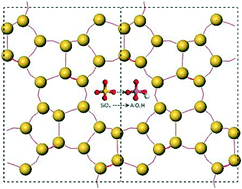Location, distribution and acidity of Al substitution in ZSM-5 with different Si/Al ratios – a periodic DFT computation†
Abstract
Systematic periodic density functional theory computations including dispersion correction (GGA-PBE-D3) have been carried out to characterize the location, distribution and acidity of Al substitution in ZSM-5 with different Si/Al ratios (up to 8 Al atoms). The model system is the orthorhombic phase, which has a unit cell containing 96 T sites. For one Al substitution, there are two energetically equal sites (T3 and T7) as the most stable substitution configurations. On the basis of the computed relative stability of the NH3 adsorbed states, there are three and two energetically close states at the T7 and T3 sites, respectively, indicating the equilibrium and mobility of the chemisorbed NH3 (or NH4+) among these states. For 2Al substitution, the most stable substitution configuration has Al atoms at the T3 and T11 sites, and the two most stable acidic O–H groups have the same NH3 adsorption energies. For 3Al and 4Al substitutions, not all generated O–H acidic sites are available for NH3 adsorption due to the confinement effect, and higher Al substitutions might not have advantages over lower Al substitutions for ZSM-5. Among the most stable substitution configurations for 1–4 Al substitutions, the T3 site appears most frequently and should represent the active site for adsorption and reaction.



 Please wait while we load your content...
Please wait while we load your content...